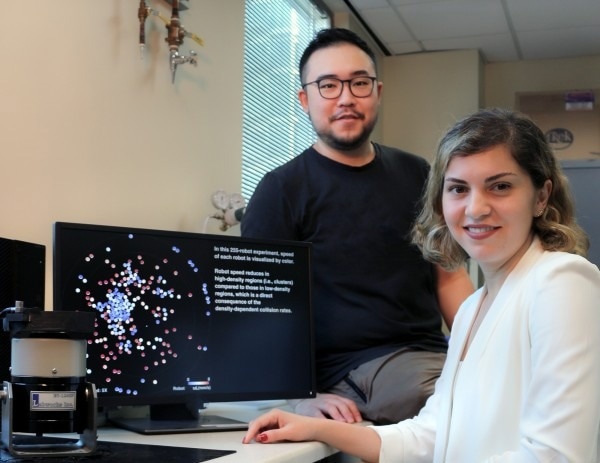Reviewed by Emily Henderson, B.Sc.Nov 10 2022
Individual robots can function cooperatively as swarms to generate significant advances in numerous areas, from surveillance to construction, but the small scale of microrobots is perfect for disease diagnosis, drug delivery, and even surgeries.
 Azadeh Ansari and Zhijian Hao. Image Credit: Georgia Institute of Technology.
Azadeh Ansari and Zhijian Hao. Image Credit: Georgia Institute of Technology.
Regardless of their potential, the size of the microrobots mostly means they have restricted sensing, motility, communication, and computation abilities, but a new study from the Georgia Institute of Technology improves their ability to cooperate in an efficient manner.
The study provides a new system to regulate the ability of swarms of 300 3-mm microbristle robots (microbots) to combine and scatter controllably without the need for onboard sensing.
The innovation is exclusive to Georgia Tech’s capability in electric and computer engineering (ECE) and robotics and its zeal for interdisciplinary partnerships.
By collaborating with roboticists, we were able to ‘close the gap’ between single robot design and swarm control. So I guess the different elements were there, and we just made the connection.
Azadeh Ansari, Assistant Professor, School of Electrical and Computer Engineering, Georgia Institute of Technology
The researchers have described the details of the study in IEEE Transactions on Robotics.
The Challenges of Microbots
While larger robots can regulate movement by sensing the surroundings and wirelessly transmitting this data to each other, microbots do not have the capacity and cannot carry the same power units, sensors, or communications. In this research, the team instead employed inter-robot physical interactions to prompt robots to swarm.
Microbots are too small to interpret and make decisions, but by using the collision between them and how they respond to frequency and the amplitude of global vibration actuation, we could influence how individual robots move and the collective behaviors of hundreds and thousands of these tiny robots.
Zhijian Hao, ECE Ph.D. Student, School of Electrical and Computer Engineering, Georgia Institute of Technology
These behaviors, or motility features, establish how microbots travel linearly and the unpredictability of their rotation. The team could regulate these motility features by employing vibration and conducting motility-induced phase separation (MIPS).
The scientists took inspiration for the concept from thermodynamics, where an agitated material can alter phases from solid to liquid to gas. The scientists exploited the vibration level to impact the microbots to develop clusters or scatter to form good spatial coverage.
To better comprehend these phase separations, they created computational models and a live tracking device for the 300-robot swarm with the help of computer vision. These allowed the scientists to examine the behavior and motion data of the microrobots that trigger the swarm’s features.
“This project is the first complete pipeline using this MIPS that can be generalized to different microbot swarms,” Hao said. “We hope people will find that using physical interactions is another new way to control the microbots, which initially was very difficult to do.”
Collaborating for Innovation
A Georgia Tech seed grant from the Institute for Robotics and Intelligent Machines (IRIM) and the Institute for Electronics and Nanotechnology supported this high-risk study.
The project’s success can be connected to the interdisciplinary nature of the study. While the ECE scientists had a wealth of knowledge in designing microelectromechanical systems (MEMS) to create technology such as microbots or computer chips, the robotics scientists shared their modeling experience.
Ansari first developed microbristle bots in 2019 from three-dimensional (3D)-printed polymers, which formed the partnership with IRIM Director and Professor Seth Hutchinson and Professor Magnus Egerstedt, currently at the University of California, Irvine, and their Ph.D. students Gennaro Notomista and Sid Mayya.
We knew more about how to build micro devices and actuate them, and they knew more about the algorithms, modelings, and closed-loop and open-loop control. So, it was very good interdisciplinary work because each group benefited from the new perspectives that the others brought to this.
Azadeh Ansari, Assistant Professor, School of Electrical and Computer Engineering, Georgia Institute of Technology
Journal Reference:
Hao, Z. et al. (2022) Controlling Collision-Induced Aggregations in a Swarm of Micro Bristle Robots. IEEE Transactions on Robotics. doi.org/10.1109/TRO.2022.3189846.